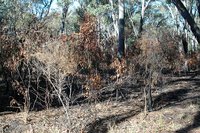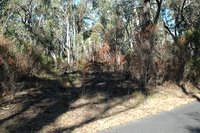 Burning the bush is a long-standing tradition of "forest management" in Australia. I believe it shows a deep seated misunderstanding of the Nature of forests.
Burning the bush is a long-standing tradition of "forest management" in Australia. I believe it shows a deep seated misunderstanding of the Nature of forests.People who burn forests in this manner seem to regard the forest as an alien element. By burning it like this, they are seeking to "dominate and control" it - instead of learning to love it for what it is.
Indeed I think this kind of burning is part of a primitive "fear response" to living in the Australian bush - something left over from our colonial heritage.
It seems to me that we have not yet learn how to live with the Australian bush.
*****
Recently there have been some "cool burns" conducted in the local Robertson area, presumably as a way of minimising the risk of a later " serious bush fire". I am not sure if these fires have been set by private land holders, the SCA, or some other Government agency. One of the fires of which I am thinking has been burnt along Kirkland Road, in East Kangaloon (just on the eastern side of the road). The other was a patch of forest along Tourist Road, in Kangaloon, past Maloney's Road, when heading towards Glenquarry. It is on the opposite side to the main "SCA Special Area", but perhaps it is SCA forest, I am not sure.
 This burning has prompted me to write about fire survival strategies of different local plants. (There will be more tomorrow.)
This burning has prompted me to write about fire survival strategies of different local plants. (There will be more tomorrow.)Firstly, the tall Eucalypts have not been damaged by the fire, except for some older trees, with hollowed out bases, which burnt up through their empty centres, and then fell over. Healthy trees were not affected. By controllling the timing the fire to the cooler months, it does not "flare" into a major bush fire (it does not burn the canopy of the forest). Hence the term a "cool burn".
However, the shrubbery is badly damaged (of course). This is my main problem with Foresters (and fire fighters), who regard the undergrowth of the forest as a nuisance.
They view it as "fuel" which, if not burnt off regularly, will greatly increase the intensity of a fire in summer.
By itself, that is a true statement. But it misses the point of what a forest really is.
*****
 From an environmental point of view, the shrubbery and the undergrowth is where the greatest number of plants and animals live. The forest is not just the trees which make up the canopy. I wrote about this previously, regarding the Bodalla State Forest - where rare plants were being threatened by excessive burning.
From an environmental point of view, the shrubbery and the undergrowth is where the greatest number of plants and animals live. The forest is not just the trees which make up the canopy. I wrote about this previously, regarding the Bodalla State Forest - where rare plants were being threatened by excessive burning.This kind of fire can be quite devastating, in its impact, especially if it is repeated too frequently - within about 8 years. I will explain that timing tomorrow.
The only good word I can say for this kind of forestry practice is that these fires have been successfully controlled to certain areas, and have not burnt a whole forest.
I will write again tomorrow about how different plants in the lower levels of the forest survive fires, (or do not). It is an interesting example of evolution at work, where different plants have taken different strategies with regard to fires.

No comments:
Post a Comment